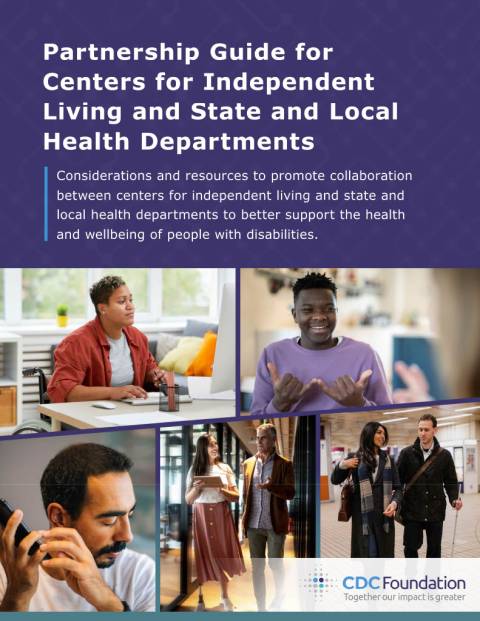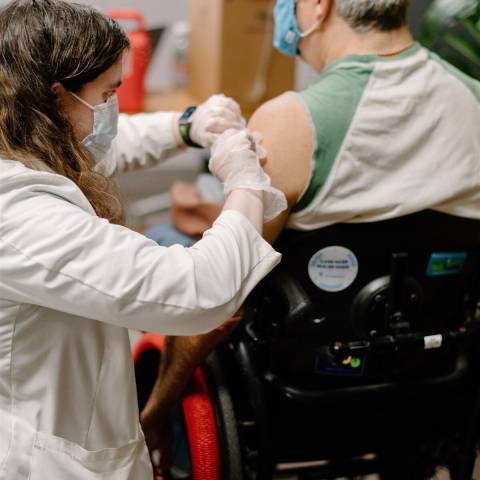You are here
ADA Anniversary: Tackling Public Health Challenges for People with Disabilities
You may not realize it, but if you’re one of the every four adults in the United States with a disability, you’re part of the largest minority group in the country. Or you may be all too aware, considering the challenges you might have encountered accessing healthcare on a regular basis. And the COVID-19 pandemic only presented new obstacles for people with disabilities, like trying to get an appointment for a vaccine or getting transportation to a clinic.
In October of 2021, the Centers for Disease Control and Prevention (CDC) released a report noting that people with disabilities were less likely to be vaccinated, even though they were more willing to do so than the general public. At that time, CDC recommended making health messages and vaccination information available in American Sign Language (ASL), braille and easy-to-read formats as well as making vaccination sites more accessible to persons of all ability types, including those with intellectual and/or sensory disabilities. CDC also recommended finding a way to get COVID-19 vaccinations directly to those who were unable to leave their homes easily or independently.
Partnership Goals
Based on the COVID-19 experience, the CDC Foundation began working with partner organizations to promote local collaborations aimed at tackling public health challenges for people with disabilities. And today, on the 33rd anniversary of the Americans with Disability Act, comes the result of that project, a Partnership Guide for Centers for Independent Living and State and Local Health Departments.

This publication is designed to help disability-led organizations and health departments understand each other’s structures and goals while providing tips and best practices for creating strong partnerships to better serve the needs of people with disabilities. The CDC Foundation produced the guide in partnership with local groups, collectively known as Centers for Independent Living.
Centers for Independent Living
Despite their name, Centers for Independent Living (CILs) do not offer residential services, like group homes or assisted living facilities. Instead, they’re community-based non-profit advocacy organizations that are designed and staffed by people with disabilities to provide various services to empower individuals in their own communities.
“Our CIL provides braille instruction, collaborates with organizations on emergency preparedness, teaches independent living skills… and provides pre-employment training for youth in schools,” explains Pam Davies of the Western Reserve Independent Living Center in Northeast Ohio.

Collaboration with Local Health Departments
And these attributes make CILs excellent partners for state, local, tribal and territorial health departments when planning and enacting quick responses to events like severe weather, wildfires and other emergencies, as well as general public health efforts like education and prevention.
Alex Mikowski of Access to Independence of Cortland County, Inc., New York, reports her organization has collaborated closely with their local health department on a number of projects. “We’ve provided input about the accessibility of emergency response materials, such as large print or videos with captions. We also do a lot of events together, promote each other’s materials, and give referrals back and forth for customers to receive services. Our CIL often provides equipment, such as wheelchairs, to our health department for their events.”
Together Our Impact Is Greater
The Partnership Guide was produced with input from 39 CILs and 19 health departments across the United States. Organizations including Able South Carolina and Independent Living Utilization Research (ILRU) worked closely with the CDC Foundation to create the accessible digital guide. It’s filled with tips on how to develop partnerships, examples of successful collaborations and dozens of resource links.
“CILs have proven to be strong partners with state and local health departments in emergency response, and I’m excited to see new and even stronger collaborative efforts fostered through the use of the Partnership Guide,” says Federal Project Manager LaTasha Callis, who helped lead the effort.
This blog and project were supported by the Centers for Disease Control and Prevention of the U.S. Department of Health and Human Services (HHS) as part of a financial assistance award totaling $7,220,000 with 100 percent funded by CDC/HHS. The contents are those of the author(s) and do not necessarily represent the official views of, nor an endorsement, by CDC/HHS, or the U.S. Government.
